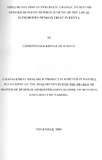| dc.description.abstract | Local authorities Pension Trust, like any other organization whether in public or private
organization is directly or indirectly affected by the changes taking place in the environment in
which they operate. It therefore becomes apparent for organizations to prepare themselves by
formulating and implementing strategies that will enable them to exploit the opportunities and
keep threats at bay.
Strategic change management is now a bell weather event hence is a routine management issue
that requires concentration for its benefits to be realized. Laptrust has undergone substantial
metamorphosis and has lived to see the challenges so much so that during the period of
liberalization in the late 1990’s through early 2000 in Kenya saw it readjust its operational
activities in the quest of establishing a viable fit in the retirement benefits industry. There were
challenges such as cut throat competition, high customer expectations, inflation and in the late
2002, the birth of regulator (RBA) which came with stringent rules regarding investment
portfolios by the players in the industry.
The global trend in the social security industry where pension schemes are shifting from
defined benefits to defined contributions owing to the challenges associated to the former than
the later such as; liability remaining with the sponsor ( scheme) in case of underfunding, the
predetermination of benefits, the use of formula to compute benefits, and the incorporation of
period of service rather than contributions received to establish the payable benefits, all poses a
challenge to the scheme to warrant strategic change process.
vii
The study therefore sought to establish how strategic change management has been
implemented to sustain the defined benefits pension scheme by Laptrust. The study involved
collection of both primary and secondary data from various sources in the organization. The
findings were that, the change management process is planned. The entire organization owns it
both bottom up and top down. A task force was appointed in 2005 which carried out a sample
survey of the business processes vide a pilot SWOT analysis and some of the areas under study
were, business processes, employee working relations, working tools sufficiency, staff
competences, membership records update, debtor status among others.
With the help of consultants, the findings were discussed and proposals made and presented to
the board of trustees whose receptive support made the project see the light of the day. As a
ground breaking exercise to pave way for the reforms, the schemes name was ceremoniously
changed from the very long KLGOSF to LAP Trust, followed by other crucial internal
changes. Lap Trust launched its vision, mission and strategies to address the critical issues
threatening the sustainability of the defined benefit scheme. Despite the various constraints,
change management made considerable gains ranging from; increased membership from
10,000 to 27,000 within a period of three years; enhancement of human resource from 30-70
competent staff; effective and efficient ICT; effective customer care; enhanced business
portfolios hence growth of asset base from Ksh 3 billion to 7 billion. | en |

